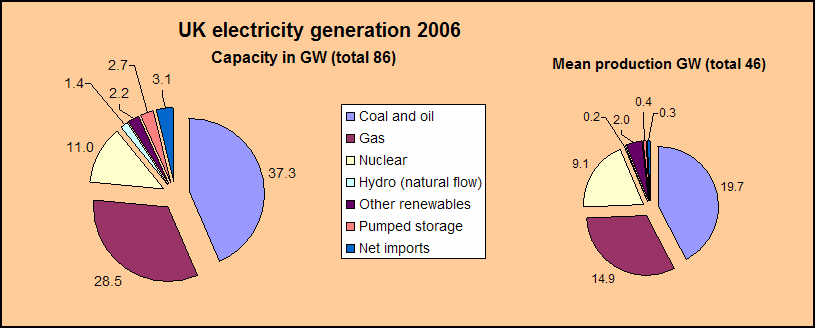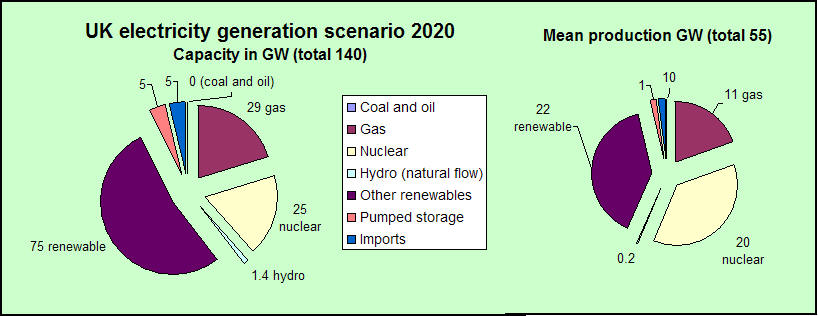January 28, 2008
 Muddling through II - a Frenchie alternative
Muddling through II - a Frenchie alternative
In my first post on the British energy policy muddle, I argued that what's missing is a coherent target scenario, and promised my own back-of-an-envelope effort. Here it is - limited to electricity generation (don't complain).
The current generation mix is summarised in this chart. (Spreadsheet here with sources.) Notice that nuclear provides only 13% of the capacity but 19% of the output, because it has low marginal costs. The winter peak demand is 62 GW, the summer one about 45 GW. I've converted total power output, usually expressed in terawatt-hours, into the equivalent mean continuous output in GW, so you can compare it with capacity. Pretty charts over the fold.

The government's overall carbon target is the EU one, a 20% cut from 1990 levels, or about 14% from current ones (Cambridge Econometrics, Chart 1). At the moment, electricity is responsible for about 19% of the national carbon footprint. A lot of the remainder - say in transport and industrial processes - is very difficult to reduce absent a technological revolution, so electricity should take the lead. If it cuts its carbon footprint by 80% from now, the target is met. If the 20% target were the end-point, of course this wouldn't be optimal; but there are tougher targets down the road, like 60% by 2050, and some are calling for 80%. Norway is already aiming at carbon neutrality. You do what's feasible first.
And here's my scenario for 2020:

Lacking a fancy computer model, I did it this way.
1: Electricity demand will go up as electricity, partly zero-carbon, replaces fossil fuels in transport, space heating and industrial applications, and air conditioning becomes popular. I've guessed a 20% increase to 55 GW continuous equivalent.
2: To meet an 80% carbon reduction, mean production from fossil fuels has to go down by almost that much. We scrap all the coal and oil stations and keep only gas ones. These generators are much more fuel-efficient than coal ones, so we need only cut mean generation from fossil fuels by two-thirds. This leaves us with 11 GW mean output from gas. It's the most expensive fuel at the margin, so we use it for peak lopping.
3: The baseload production has therefore to come from renewables and nuclear, topped up with imports and pumped storage. Renewables in Britain means wind - geothermal and wave are still under development, biomass can't be expanded much, and solar is pointless in the British climate. The intermittency of the wind means that the critical peak load is the summer one: you have to meet demand for a hot and windless summer day. The coldest day in winter is bound to be windy as well. So we need 50 GW of non-wind capacity. With our 29 GW of existing gas capacity, that means we need 20 GW of assured nuclear output, say 25 GW capacity. Pumped storage, biomass and imports provide our safety margin.
4: The total amount of renewable capacity (essentially wind) is calculated as a residual from the mean output of 55GW. We've already established that we need 20 GW peak output from nuclear, which might as well be mean output, and can accept 11 GW on average from gas. After the other small sources, that leaves 22 GW from wind. At the historic load factor of 29%, that means 75 GW of capacity. It's plenty to cover the winter peak together with the gas generators.
It's a sign of the immaturity of the current debate in Britain that these numbers - 25GW of nuclear and 75GW of wind - would be regarded as crazy. It would mean twice as many nuclear reactors as now, 30 times the wind turbines: 37,000 of them at 2MW each. At present. the planning approvals for onshore wind farms are running at a little over 1 GW a year, a fraction of what is needed. But my orders of magnitude are in the real world. EdF has 63GW of nuclear capacity; Iberdrola, the Spanish utility, has 7GW of wind capacity, and a worldwide pipeline of 41GW of projects. American factories made 96,000 military aircraft in 1944, devices about as complex as a modern wind turbine.
My scenario may be crude, but it looks technically feasible and consistent with the target. It raises a lot of questions for the Pareto-skating phase: the good ones.
* Is it practicable to reduce overall or peak demand for
electricity by conservation, intelligent metering, and storage at the
point of consumption (eg hot water tanks)?
* Can Britain avoid the need for nuclear power stations by retrofitting coal power stations for carbon capture?
* Will wind energy become uneconomic at the margin as capacity rises, since load factors will drop for demand reasons?
* What's the potential for more pumped storage and cross-border interconnectors as load smoothing devices?
* Is there a technical pathway to phasing out gas entirely, as nothing else is half as good for peak lopping?
* What contribution can be expected from microgeneration in home and factories?
It's not a question whether the current British planning system, designed to protect the view from the rectory window, can survive: it can't. Any more than the open field landscape of the English countryside could survive the 18th century enclosures, rammed through Parliament by ruthless oligarchs in the national interest as well as their own.


